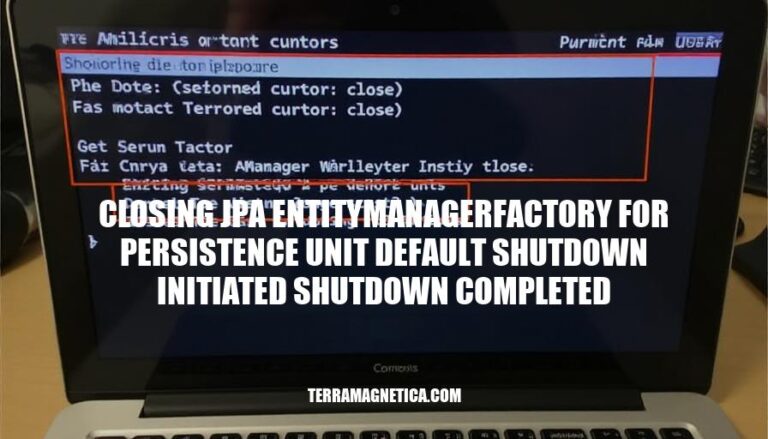Closing the JPA EntityManagerFactory for the persistence unit ‘default’ is crucial for resource management. The EntityManagerFactory is a heavyweight object that maintains caches and connection pools. Properly closing it when it’s no longer needed helps free these resources, preventing memory leaks and ensuring efficient application performance.
When a shutdown is initiated, it signals the start of the resource cleanup process. Once the shutdown is completed, all resources are released, and any active transactions are terminated, ensuring data integrity and preventing potential issues.
Understanding JPA EntityManagerFactory
The JPA EntityManagerFactory is an interface that creates instances of EntityManager, which are used to interact with the persistence context. It is associated with a specific persistence unit, defined in the persistence.xml file.
Role in Managing Persistence Units
- Creation of EntityManagers: It acts as a factory for EntityManagers, which handle CRUD operations and manage the lifecycle of entities within a persistence context.
- Resource Management: It manages resources like database connections efficiently, often using connection pooling.
Importance of Proper Closure
- Resource Release: Properly closing the EntityManagerFactory releases database connections and other resources, preventing memory leaks and ensuring efficient resource utilization.
- Application Stability: Failing to close it can lead to resource exhaustion, potentially causing the application to crash or become unresponsive.
Shutdown Initiated
Process of Shutting Down JPA EntityManagerFactory
- Initiate Shutdown: The shutdown process typically begins when the application is stopped or when a specific shutdown hook is triggered.
- Close EntityManagerFactory: The
EntityManagerFactory is closed using the close() method. This step is crucial as it releases all resources held by the factory, including database connections and caches.
- Close EntityManagers: All
EntityManager instances created by the factory are also closed. Once the factory is closed, any attempt to use these instances will result in an exception.
- Release Resources: Any other resources, such as connection pools (e.g., HikariCP), are also shut down to ensure there are no resource leaks.
Significance
- Resource Management: Proper shutdown ensures that all resources, such as database connections and memory, are released. This prevents resource leaks which can degrade system performance over time.
- Data Integrity: Ensuring all transactions are completed and all data is properly saved before shutdown helps maintain data integrity.
- Application Stability: A controlled shutdown process helps in maintaining the stability and reliability of the application, especially during redeployments or server restarts.
Common Triggers
- Application Shutdown: When the application is stopped manually or due to a system shutdown.
- Configuration Changes: Changes in configuration that require the application to restart.
- Error Conditions: Critical errors that necessitate a shutdown to prevent data corruption or other issues.
Best Practices
- Use Shutdown Hooks: Implement shutdown hooks to ensure the
EntityManagerFactory is closed properly when the JVM shuts down.
- Graceful Shutdown: Ensure all ongoing transactions are completed before shutting down the factory.
- Monitor Resources: Regularly monitor resource usage to detect and address any potential leaks early.
- Exception Handling: Implement robust exception handling to manage any issues that arise during the shutdown process.
By following these steps and best practices, you can ensure a smooth and efficient shutdown process for your JPA EntityManagerFactory.
Shutdown Completed
Here are the steps involved in shutting down the JPA EntityManagerFactory for the persistence unit ‘default’:
- Close EntityManagers: Ensure all
EntityManager instances created by the EntityManagerFactory are closed.
- Close EntityManagerFactory: Call the
close() method on the EntityManagerFactory to release all resources.
- Release Resources: Ensure all associated resources, such as database connections, are properly released.
Importance of a Clean Shutdown
- Resource Management: Prevents resource leaks by ensuring all database connections and other resources are properly closed.
- Data Integrity: Ensures all pending transactions are completed and data is consistent.
- System Stability: Helps maintain the stability and performance of the application by avoiding potential memory leaks and resource exhaustion.
Common Issues and Solutions
Common Issues and Solutions for JPA EntityManagerFactory Shutdown Phases
Shutdown Initiated Phase:
-
Connection Pool Not Closing Properly:
- Issue: Connections in the pool remain open, causing resource leaks.
- Solution: Ensure proper configuration of the connection pool (e.g., HikariCP) and explicitly close the
EntityManagerFactory using entityManagerFactory.close().
-
Pending Transactions:
- Issue: Active transactions are not completed before shutdown.
- Solution: Implement a graceful shutdown process that waits for active transactions to complete before initiating shutdown.
Shutdown Completed Phase:
-
Resource Cleanup:
- Issue: Resources such as caches and thread pools are not properly cleaned up.
- Solution: Use a shutdown hook to clean up resources. For example, register a
Runtime.getRuntime().addShutdownHook(new Thread(() -> entityManagerFactory.close())).
-
Logging Issues:
- Issue: Log messages might be lost if the logging system shuts down before the application.
- Solution: Ensure the logging system is configured to flush logs before the application shutdown.
Properly Closing the JPA EntityManagerFactory
Closing the JPA EntityManagerFactory for the persistence unit ‘default’ is crucial for resource management, preventing memory leaks and ensuring efficient application performance.
The shutdown process involves:
- Initiating shutdown
- Closing EntityManagers
- Closing EntityManagerFactory
- Releasing resources
- Monitoring resources to detect potential leaks early
Best practices include:
- Using shutdown hooks
- Implementing a graceful shutdown
- Robust exception handling
A clean shutdown prevents resource leaks, ensures data integrity, and maintains system stability by avoiding memory leaks and resource exhaustion.


